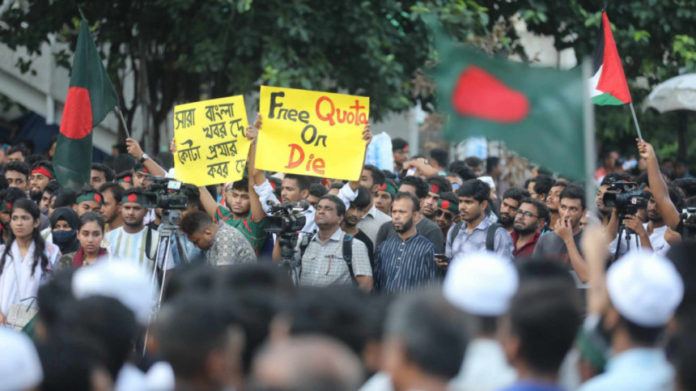2024 protests in Bangladesh that led to the overthrow of Sheikh Hasina’s government, emphasizing the role of youth activism and social media in demanding democratic reforms. It also discusses the decline of traditional aristocracy and the emergence of a new political elite. The piece highlights the challenges ahead for establishing a transparent and inclusive governance framework.
Bangladesh, a country known for its rich cultural tapestry and Chaotic history, is now experiencing the gradual fading of its aristocratic legacy. Bangladesh’s aristocratic class now finds itself increasingly unimportant in a rapidly modernizing and democratic society. The change in order just not marks the end of an era but the dawn of a new chapter in history. In this new chapter of Bangladesh, every voice had the potential to matter and contribute.
Bangladesh’s aristocracy originated in the Mughal era when large tracts of land and titles were granted to loyal subjects. These Zamindars and Nawabs became the dominant class maintaining influences through British rule and after the 1947 partition that established East Pakistan. The 1971 Liberation War marked a significant turning point and initiated transformative change in Bangladesh.
The Emergence of New Aristocracy
Following the Liberation War of 1971, Sheikh Mujibur Rehman, known as Father of the Nation, came to power and commenced the establishment of a new Bangladesh. In Spite of his commitment to democratic principles, a new type of aristocracy began to emerge under his leadership. The political elites, centered around the Awami League and closely tied to the Rahman family, started to accumulate significant influence. This new aristocracy based on political power rather than ownership of land, began to dominate the social and political environment of Bangladesh.
Sheikh Mujibur Rahman was executed in 1975, which caused a lot of chaos in Bangladesh. However, his legacy lived on. His Daughter, Sheikh Hasina, took over the Awami League in the 1990s. Under her leadership, the power of the Awami League grew stronger. Also the government of Bangladesh at that time got close with the Hasina Family, with a lot of power held by them and their close friends.
Political and Economic Gains
Sheikh Hasina’s tenure saw significant economic growth and development. Under her leadership, Bangladesh transformed into one of the fastest-growing economies in the world. This impressive progress was largely fueled by the textile industry, robust remittance inflows, and major infrastructural initiatives. However, this economic success was frequently overshadowed by allegations of corruption, nepotism, and a trend towards the centralization of power within the government.
As with most governments, Sheikh Hasina’s administration left some loopholes, and the country’s progress was not without its challenges. Despite reaching new heights, the government faced criticism for its handling of opposition and civil liberties. Moreover, the concentration of power and alleged human rights abuses raised concerns about the country’s so-called democratic trajectory.
Like many governments that have touched the sky, Bangladesh’s progress followed a decline. History has shown that even the most successful governments can fall victim to complacency, corruption, and authoritarian tendencies. The same happened with the government of Bangladesh.
Student Protests and the Overthrow of Sheikh Hasina
By 2024, a wave of dissatisfaction with the Hasina government has reached a critical point. Accusations of autocratic government, suppression of dissent, human rights violations, and economic inequalities fueled public unrest. The youth, especially students who face high unemployment and limited opportunities emerged as the leaders of the protest movement.
The students or may be called Gen Z erupted in protests in major cities calling for democratic reforms, transparency, and accountability. Social media played a vital role in rallying support and spreading information, bypassing state-controlled media channels. On 2 August 2024, In response to mounting unrest, the Bangladeshi government imposed a nationwide ban on several popular social media platforms, including Instagram, TikTok, WhatsApp, and YouTube. The move aims to curb the spread of protest-related content online. Also, the government’s heavy-handed response, which included arrests and violence against protestors, only escalated the unrest.
The finale of the protests resulted in the overthrow of Sheikh Hasina’s government, making an end of a political dynasty that had dominated Bangladesh for decades. The fall of Sheikh Hasina represented not just a significant rejection of the entrenched ruling oppressors that had long governed Bangladesh.
Escalating Fatalities
The death toll in the anti-government protests in Bangladesh on Tuesday (August 6, 2024) climbed to 440, with 100 more deaths reported after Sheikh Hasina fled the country, according to local media, even as efforts were on by the army to bring the situation under control in the violence-hit nation.
500 people were brought to the hospital with various injuries, including bullet injuries, on Monday (August 5, 2024). At least 24 people were burnt alive last night in a hotel owned by a leader of Awami League in western Joshor district,” hospital sources said.
The Road Ahead
The road ahead for Bangladesh will be difficult. Expectations will be high and people want early elections. The new leadership, born out of student protest, faces the enormous task of rebuilding a democratic framework, ensuring political inclusivity, and addressing economic disparities.
The challenge lies in balancing rapid modernization with social justice, creating a political environment where power is decentralized and governance is transparent. The youth, who played a pivotal role in this political revolution, are now the torchbearers of change. Their aspirations for a more just, equitable, and democratic Bangladesh will shape the future trajectory of the nation.
The most important challenge in the current situation is to yield maximum output from this leaderless or headless movement and to safeguard this revolutionary approach from a counter-revolutionary mindset like that of Iran and Russia and to ensure a peaceful transition which has been very unlikely to happen, in similar movements in the past in different regions of the world




